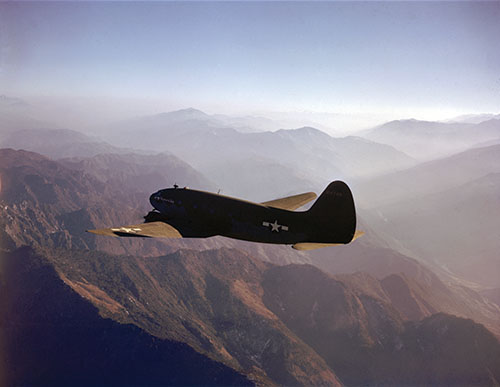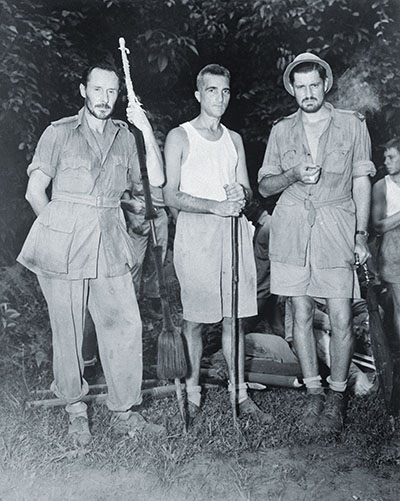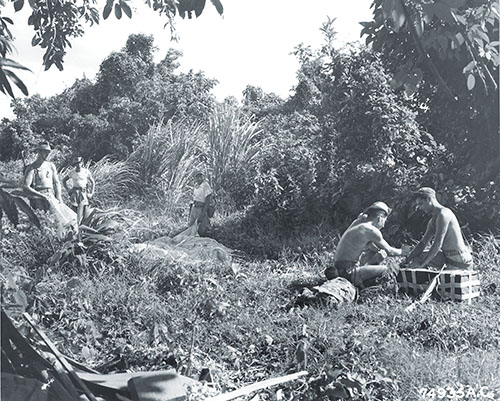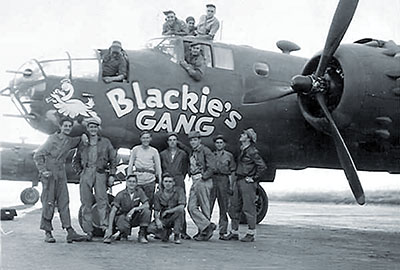“Know what?” The young corporal shouted to CBS correspondent Eric Sevareid. “Left engine has gone out.” The corporal grinned broadly in an “I-told-you-so” sort of way. Sevareid knew the U.S. Army Air Forces’ Air Transport Command (ATC) had been struggling with the C-46, which ATC pilots dubbed the “Curtiss Calamity” and “Flying Coffin.” Even technical experts from Curtiss-Wright were afraid to fly in their aircraft over the “Hump”—the line of Himalayan mountains and Burmese jungles that had to be crossed at great risk to resupply the Nationalist Chinese. Hump pilots, wrote Sevareid, “could plot their course to China by the line of smoking wrecks upon the hillsides.” Others sardonically termed it the “aluminum trail.”
The August 2, 1943, flight—designated ATC Flight 12420, bound from Chabua in northeast India’s Assam Province to Kunming in southwest China’s Yunnan Province—was unusual because it carried 18 military and civilian passengers, but no cargo. The 30-year-old Sevareid, already famous for his war coverage in Europe, was traveling at the behest of the White House to assess the impact of this perilous and costly aerial lifeline: Was China’s Chiang Kai-shek using American men, aircraft, arms, and supplies to battle the Japanese or to benefit himself?

As the crippled C-46 turned back toward India, its crew chief tore open the cargo door and began tossing out the passengers’ luggage to save weight. Sevareid spotted the burly radio operator, Staff Sergeant Walter Oswalt, “bending over the instruments, quickly turning the dials.”
The passengers began strapping on their parachutes; moments later, the more courageous among them started to jump, each leaping out froglike and vanishing with a whistling sound. Sevareid and others hesitated until they saw the plane’s young pilot, Flight Officer Harry Neveu, donning his chute. Sevareid finally bailed out and pulled his ring. His parachute’s rapid opening jolted his body. Ahead he saw a green mountain and a geyser of orange flames suddenly explode on its slope. The C-46 had crashed. Below him was a village of grass huts and a brown river snaking along a valley, but he could not see any roads or trails. Then everything went dark as tree branches slashed at him and he tumbled head over heels.
IN EARLY APRIL 1942, Colonel William D. Old, piloting a Pan-American Airways Douglas DC-3 from a jungle airfield, became the first U.S. Army pilot to make the treacherous run from India to China. He vaulted his twin-engine cargo plane over 14,000-foot peaks, carrying cargo marked supersecret: cans of 100-octane gasoline and lubricants to replenish the Doolittle Raid’s B-25 bombers in China after they bombed Tokyo. Old’s flight had little immediate effect—most of the Doolittle bombers had crash-landed across eastern China—but that first aerial trip over the Hump introduced new possibilities for long-range resupply.
Within days of Old’s flight, Colonel Caleb V. Haynes, a former B-17 pilot with Thai and Chinese ancestry, took charge of the Assam-Burma-China (ABC) Ferry Command, as ATC was then known. As Burma was falling into Japanese hands, Haynes’s civilian DC-3s and military C-47s performed double duty, delivering supplies to Claire Chennault’s Flying Tigers and the Chinese army while shuttling wounded soldiers and civilian refugees to safety. They lost no transports during the evacuation, but ground crews struggled desperately to keep their aircraft flying through the April-to-October monsoons. Throughout that time, the unit was short on reserve aircraft and spare parts. By cannibalizing one damaged aircraft, they could put four grounded planes back in the air. And a shortage of mechanics impelled truck drivers and cooks to double as maintenance personnel.
By December 1942, Japan controlled all land routes and ports into China, blockading the country except by air. The U.S. Army Air Forces reorganized ABC Ferry Command as the India-China Division (ICD) of the global Air Transport Command and brought in large capacity C-46s and C-87s to increase the Command’s cargo volume. Additional crews and service personnel arrived, but living conditions at the new bases in India’s Assam Valley were appalling, the training haphazard, and daily operations chaotic. One colonel—noticing his ill-prepared colleagues, some with hands in their pockets, placidly watching an incoming Japanese air raid—barked at them, “Take cover, you dumb bastards!” Thereafter, headquarters became known as “Dumbastapur.”
In each of its variations, ATC faced the challenges of rescuing aircrews forced to bail out over rugged mountains and jungles. Because of aircraft scarcity and operational chaos, the Command’s recovery efforts were impromptu with inconsistent results. Once an airplane was classified as missing, the next available crew took off on a search. They did their best despite inadequate equipment, delayed reports, meager information, and unfavorable weather.
In those early days, aircrews who survived crashes and safely returned defied the odds. In November 1942, copilot Lieutenant Cecil Williams and radio operator Corporal Matthew Campanella bailed out of a transport lost in a storm returning from China. They were remarkably lucky to reach a friendly village amid vast territory dominated by a tribe of fierce Naga headhunters. Survival odds only deteriorated when the Japanese began offering a bounty: 300 rupees—about the same value in dollars—for every GI head produced. Things got even worse by the following spring, when flight schedules were ramped up. During the second half of 1943, the Hump claimed an average of one aircraft a day.
THE FIRST PASSENGER TO BAIL OUT of Flight 12420’s ill-fated C-46, John “Jack” Paton Davies Jr., a 35-year-old U.S. State Department representative to the China-Burma-India Theater, landed near three American soldiers and a Nationalist Chinese officer. The small party soon encountered six near-naked, spear-wielding tribesmen. More curious than hostile, the local warriors led the survivors to a village on the crest of a ridge just inside the Burmese border. From there, Davies saw smoke rising from the C-46’s crash site and, to his welcome amazement, a C-47 circling above it.
Davies scribbled a note—“Those who bailed out this morning should join the rest of the party at the village. The bearer will lead you. This means you, too, Eric.”—and gave it to a tribesman, who trotted west toward the crash site. In the evening, as Davies’s group sat uneasily through a ritual dinner celebration, the messenger returned with a response from Sevareid: “Eleven men here—2 have bad legs—supplies dropped here, plane will return here—rescue party on way—please come here—we are about one mile south of the wreck.”
Davies and his colleagues, accompanied by five tribe members, set off for Sevareid’s position. After hours of trekking through the jungle in the dark, being soaked in a sudden downpour, and arriving at their compatriots’ location the next morning, Davies capped the journey with a wry salutation: “Dr. Sevareid, I presume?”

Only after that did Davies realize the extent of their collective good fortune—and the peril they still faced. Of the 18 passengers and four crew, just one man, copilot 1st Lieutenant Charles Felix, had perished in the crash. C-47s were dropping supplies and survival instructions. Additionally, Lieutenant Colonel Donald D. Flickinger, a surgeon, and two combat surgical technicians had parachuted in to care for the injured, the worst of whom was radio operator Oswalt with a broken leg. By all accounts they had Oswalt to thank for the prompt first aid. “This was Oswalt’s work,” Sevareid recalled: “the man who had repeated our distress signal and our position over and over again.”
The survivors had landed in the Patkai Range between India and Burma, about 85 mountainous miles east of the nearest British administrative facilities at Mokokchung. Pangsha, the village hosting the men, was home to particularly warlike Naga tribesmen. Three years before, colonial troops had staged a punitive expedition against Pangsha to try and curtail the Naga’s pillaging, enslavement, and headhunting.
For the previous six months, the British administrator, Philip Adams, had sent word through the hills that any parachutists were to be helped, not killed. That may have been the only reason the foreign strangers still had their heads. Adams instructed the survivors to stay put until he could arrive with a rescue party and lead the group to Mokokchung.
The survivors sweated out another 10 uneasy days before Adams, accompanied by two American soldiers, many porters, and 60 shotgun-toting Naga bodyguards, finally reached Pangsha. Sevareid immediately sized up the tall, slim, fair-haired Adams as “the Sahib of Mokokchung, king of these dark and savage hills.”
Adams’s column began its trek on August 18, stretching for nearly two miles. Porters carried Oswalt and a Chinese officer on bamboo litters; the others walked. Each day’s journey, usually about 15 miles and shepherded by ATC aircraft, ended at tribal village waystops: Noklak the first night, Chingmei on August 19, Kuthurr on August 20. For Sevareid, August 21 proved to be the worst. “Down to the river, then three-hour climb,” he recalled. “I could not do it again.”
At the end of that day the group was in Helipong, 8,000 feet high and level with the clouds. After what Sevareid called the “shortest, easiest hike of all” on August 22, the party scuttled downhill through heavy rain to reach Chare on August 23. “Now suddenly,” wrote Sevareid, “all feeling of wilderness, of danger, has gone.” Across a valley they could see Mokokchung, which they finally reached on August 24, just 22 days after their C-46 crash. During their last village stop, a tribal bodyguard pulled aside one survivor, a GI named William Schrandt, to explain the geography. “India there,” the tribesman said, pointing west. “China there,” he said while pointing east. And then, pointing skyward, he said: “America there.”

FROM THE OUTSET, the “Sevareid rescue” was a special case. With 21 survivors, it was—and remains—the largest single aircraft parachute escape. That the survivors included a famous journalist, an American diplomatic envoy, and several influential American and Chinese officers guaranteed it got publicity—publicity that had important, long-term implications. By calling attention to the inherent danger of the Hump mission, the Sevareid rescue inspired the formation of a dedicated search-and-rescue service for the region.
Captain John L. “Blackie” Porter, 27—a ferry pilot with more than 2,000 flying hours in various aircraft and five transatlantic crossings to his credit—had been flying the Hump since June and pushing for an organized rescue service. Motivated by the Sevareid rescue, Porter, who owed his nickname to his dark eyes and a shock of thick black hair, cobbled together equipment and personnel for a group that became known as “Blackie’s Gang.”
One early recruit was Walter Oswalt, Flight 12420’s radio operator. Another was Joe Kramer, a former New York nightclub operator who oversaw a warehouse stocked with rescue gear—food, medicine, bandages, boots, clothes, compasses, maps, signaling panels, playing cards, books, Bibles, plus other goods to barter with native tribes. The third was Bill Blossom, a trained parachute rigger. As it turned out, Blossom never rigged a chute for Blackie’s Gang. Instead, after Porter procured “another rigger who didn’t care to fly,” Blossom became an air crewman. He described Porter as a reserved and gentle man who “became a fearless daredevil” once airborne. “He gave us a singleness of purpose!” Blossom said. “He raised our sights.”
The four officers and 10 enlisted men of Blackie’s Gang received the ATC’s official approval on October 25, 1943—along with two old C-47s, based at the Chabua airfield. Although the twin-engined C-47 was an unarmed transport aircraft, that did not prevent Blackie’s Gang from improvising at aerial combat. On their flights they usually carried two British Bren light machine guns that could be fired from the cargo door or the cockpit windows.
Occasionally the Brens even became unlikely offensive weapons. During a search mission on November 6, Porter spotted a disabled Japanese A6M Zero fighter on the ground at a remote Burmese airfield; its pilot was perched on the wing. Porter turned over the controls to his copilot, 1st Lieutenant Walter Gayda, and leveled one of the Brens out the cockpit window. Porter repeatedly shouted to Gayda to “slow down!” as he and a fellow crewman fired at the Japanese aircraft. They made seven passes, destroying the Zero and killing or wounding its pilot. The crew subsequently painted a small Japanese flag on the C-47’s nose to signify the combat kill.
Without established search-and-rescue doctrine, the strafing of the Zero was just one example of how the offense-minded Porter conceived a multifaceted role—search, rescue, and revenge—for his Gang. In late November that role broadened with the acquisition of two salvaged B-25 Mitchell medium bombers, which they named Blackie’s Gang and Crazy Daisy, along with several small L-5 liaison aircraft for short-range missions.
Despite the added aerial punch, Porter and his tireless Gang did not neglect their primary search-and-rescue mandate. The daunting task included a sizeable backlog, and they improvised by pioneering new, imaginative, and risky tactics. Twice daily they flew three-to-six-hour missions, and pilots often flew with only one other crewman sitting in the copilot seat as an observer and emergency pilot. Ground crews regularly worked overnight to service the aircraft and keep them airworthy.
On rescue missions, Blackie’s Gang combed the jungle and mountains at tree-top level. When they located surviving crews—no small feat in itself—the Gang employed ever-refined air-drop, communication, and survival techniques. Volunteer medics parachuted in as necessary to treat injuries and, on one occasion, the Gang successfully dropped blood for an emergency transfusion. Beyond individual heroics, the numbers told the story. During its first three months, as historian Robert Lyman notes in his book, Among the Headhunters, Blackie’s Gang found and recovered 127 Allied air crewmen from 58 downed planes.

NOT ALL SURVIVORS had Blackie’s Gang to thank. Pure good luck—along with perseverance—occasionally played a hand. On November 30, 1943, pilot 1st Lieutenant R. E. Crozier ordered his crew to bail out directly over the Himalayas. Though it was the first parachute escape for Crozier and his four-man crew, they all landed successfully, but found themselves mountain-bound in Tibet. They encountered an English-speaking Burmese monk who escorted them to the primitive town of Tsetang. The locals had never before seen Americans; after crowding around to ogle and disparage the strangers’ flimsy clothing, they shared boots, fox-fur coats, and fur-lined caps with the crew.
After 10 days in Tsetang, the five Americans began a long, rugged trek back to India. With guides and mule pack transportation arranged by the Oxford-educated Tibetan foreign minister, they trudged over narrow, snow-covered mountain trails. High altitudes and sub-zero temperatures limited travel to five hours a day. At night they sheltered in crude mud huts and slept on the floor under fur skin blankets. Subsisting on a diet of mutton, rice, and yak milk, they completed a 30-day sojourn, surpassing the Sevareid party expedition by eight days.
Luck could be fickle, however. By the time of the Crozier crew’s return, luck was in short supply for Blackie Porter and some of his Gang.
On December 10, 1943, Porter, copilot James Spain, radio operator Oswalt, and crew were readying their B-25 for an afternoon flight when they received a “May Day” distress call from a C-47 flown by Walter Gayda, Blackie’s copilot during the November 6 strafing attack on the grounded Zero. Gayda’s C-47 was under fire from three Japanese Zeros over northeastern Burma.
Porter and his crew sprinted for their B-25. When they reached the scene a half hour later, Gayda’s C-47, its starboard engine shot to pieces, had already crash-landed. Bill Blossom, a member of Gayda’s crew that day, recalled: “We bellied in, wheels up, in the tall elephant grass. I ran back and pulled the cord for the emergency door, which flew off. We exited the plane quickly and were a safe distance when the gas tanks exploded.”
Moments after Porter and his crew spotted the flaming wreckage of Gayda’s C-47, two Zeros pounced on their B-25. Porter maneuvered to evade the attackers. Hope flickered at the sight of a large group of incoming fighters but, instead of being friendlies, the bogeys only proved to be more Zeros. They quickly shot up the B-25 and its starboard engine burst into flames.
Porter feathered the prop and headed for home on one engine with the Zeros still in hot pursuit. “Wait a minute,” a base radio operator heard Porter say. “I can’t talk now. I got to take a couple of shots at these—”
Then silence.
With the B-25’s second engine in flames, Porter ordered the crew to bail out. Copilot Spain, wearing his bulky parachute, got stuck in the cockpit’s narrow overhead escape hatch; the end seemed near until Porter pushed him free. Seconds after Spain pulled his ripcord, the B-25 smashed into a ridge and exploded, killing Porter, Oswalt, and three crewmembers. “The magnificent Oswalt met a sudden death in the mountains he had so painfully survived with us,” a mournful Sevareid later wrote. After a 15-day trek, sole survivor James Spain reached Chabua on Christmas Day.
ICD SEARCH AND RESCUE continued to mature in the wake of Porter’s death and, on February 1, 1944, was reestablished as the 1352nd Army Air Forces Base Unit (AAFBU), with more than 200 skilled personnel devoted exclusively to the search and rescue of downed Hump airmen. The unit continued to innovate, pioneering new and effective rescue tactics. They used small L-4 and L-5 aircraft to extract airmen—one by one—from crude airstrips carved out of jungle clearings and mountain plateaus. In one instance, they extracted a paralyzed flier, Lieutenant Robert Wesselhoeft, from mountainous terrain near the China-Tibet border. In April 1944, the unit was the first to use a helicopter to rescue a downed airman in Burma.
Due to the 1352nd AAFBU’s determined efforts, aircrew bailing out over the Hump stood a better than three-to-one chance of returning alive. The percentage of saved personnel steadily mounted: from 62 percent in 1943 to 77 percent during the first half of 1944. By war’s end, 1,171 lives were saved from 590 Hump crashes. Search-and-rescue training and tactics, first officially developed and honed by Blackie’s Gang, directly influenced
military and civilian pararescue operations that continue to this day. ✯
This story was originally published in the November/December 2016 issue of World War II magazine. Subscribe here.





